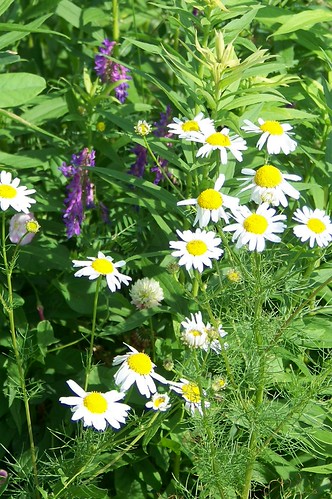
Last weekend, I made a trip to the Toronto region to visit relatives. Close to the place where I was staying in suburbia, there is a little plaza that features an A&W and a bank. It was constructed a couple of years ago. Across the front of the property, a landscaped garden separates the parking lot from the sidewalk and street. I think they did quite a nice job. The strip makes an attempt at looking ‘natural’, with tall grasses, coneflowers, rugosa roses, a swath of daylilies and small shrubs. It was planted last summer and is just beginning to fill in and take hold. Not exactly native, but they tried. At the edge of the property, the landscaping abruptly ends. A sign indicates that a zoning change has been requested to expand the parking lot.

The plot just beyond the landscaped area has a dense plant cover, and it is much more raucous than the orderly planted strip. The bare ground left behind by the developers has quickly been taken over by a host of opportunists. No tidy patches of plants here, but a jumbled free-for-all as the invaders jockey for a good position. I took my camera and walked along the edge of the rough territory, recording the occupants closest to the sidewalk. I made no attempt to be all-inclusive, but just photographed what caught my eye. Here’s what I found.

There was a big patch of Canada Thistle (Cirsium arvense), also known as creeping thistle. In spite of its name, Canada thistle is not a native plant at all. It arrived from Eurasia in the 1700s. It forms clonal colonies, spreading by deep underground runners until the ground around the first plants is a maze of thistles. All of the plants in a colony are either female or male. One female plant can produce up to 40,000 seeds, and each hardy seed can survive up to 20 years.

The dried seed-heads of Common Teasel (Dipsacus fullonum) were poking up, scattered throughout the area, and this year’s crop was underway. Another European import, dried teasel heads were once used in industry to raise the nap on woolen fabrics. Teasel was once cultivated in New York state for use by the fabric industry. Now it is naturalized throughout much of North America.

Check out this fire hydrant! In the event of a fire, I hope the firemen will be able to find it! It has been embraced by Field Bindweed (Convolvulus arvensis). You won’t be surprised to learn that Field Bindweed is a member of the morning-glory family, an aggressive black sheep of the family. Its tendrils, which wind tightly around whatever support is available, can complete a 360° twist in a bit more than an hour and a half. It’s spreading roots can reach up to 4 meters, sending out new shoots along their length. Field Bindweed is native to Europe and has naturalized across southern Canada and much of the U.S.

Adding a touch of brilliant colour is Perennial Sweet Pea (Lathyrus latifolius). It’s a native of southern Europe that has escaped from gardens in North America and sometimes moves in with a less cultivated crowd.

Here’s the sunshiny yellow of Bird’s-Foot Trefoil (Lotus corniculatus). It was introduced to North America as a source of fodder for livestock. The name ‘Bird’s-Foot’ was inspired by the seed pods, which fan out like a bird’s claw. ‘Trefoil’ comes from the latin tria foliola for three leaflets, although this variety of trefoil actually has five.

These pretty daisy-like flowers belong to Scentless Chamomile (Tripleurospermum perforata). Its finely divided leaves make it easy to differentiate it from Oxeye Daisy. It is set off here by the purple of Bird Vetch (Vicia cracca). Both Scentless Chamomile and Bird Vetch are native to Eurasia and have now naturalized across much of North America. Tucked in with the Chamomile flowers, you can also see the round pink and white globe of Alsike Clover (Trifolium hybridum). Can you guess where it is native to? That’s right, Eurasia. Like other clovers, it improves poor soil because clover roots have small nodules with bacteria that fix nitrogen in the soil, making the nutrient available to other plants.

You’ve probably heard of the literary character, the Scarlet Pimpernel. He took his name from the flower on the signet ring with which he marked the sealing wax on his letters, the Scarlet Pimpernel. Scarlet Pimpernel (Anagallis arvensis) is also known as Poor Man’s Weatherglass, because the flowers only open when the sun is shining, closing on overcast or wet days.

This healthy-looking Common or Lesser Burdock (Arctium minus) was growing at the edge of the pack. There are several types of burdock in North America, all Eurasian imports. Burdock spreads by seed, and its system for having its seed distributed is well-known to anyone who has walked though a patch of the plants and unintentionally picked up the hitch-hiking hooked burrs.

Another tall plant is Curly Dock (Rumex crispus). Reportedly, the new leaves of Curly Dock are edible, and very rich in vitamins, especially vitamins A and C. I haven’t tried them myself. Curly Dock is native to Eurasia and is a common weed around the world, with each plant capable of producing some 60,000 seeds.
Finally, rounding out this little sampling is the beautiful blue of the Chickory flower. Chickory (Cichorium intybus) has been used for food and medicinal purposes for centuries. It’s long tap-root can be dried and roasted to produce a caffeine-free coffee substitute, and young leaves may be included in mesclun salad mixes. This native of Europe is widely distributed across North America.
So there you have it, a quick overview of a dozen opportunists, and not a native North American plant amongst them.
